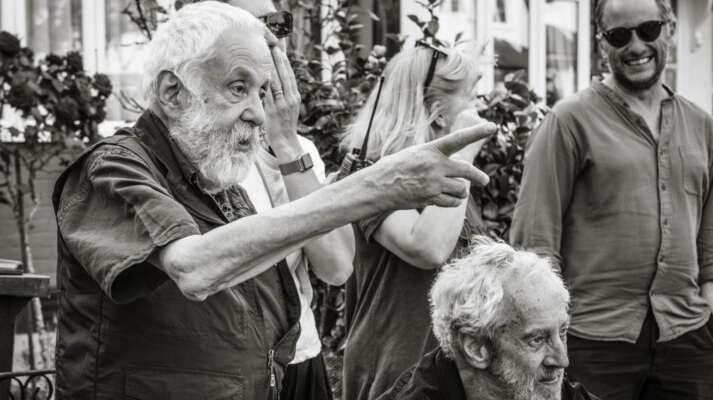Anatomy of a Monster: Reinhard Heydrich
The Butcher of Prague
Anatomy of a Monster: Reinhard Heydrich
Written by Peter Bowen
In Sean Ellis’ ANTHROPOID, Czechoslovakian resistance fighters Jan Kubiš (Jamie Dornan) and Jozef Gabčík (Cillian Murphy) risk everything to take out SS-Obergruppenführer Reinhard Heydrich. Never before had such an audacious act of resistance against the Nazis been undertaken. No one involved knew what the consequences of their actions would be, or what devastating repercussions might occur. What the Czechoslovakian people did know, however, was the dark shadow Heydrich had already cast over Europe. Although he’d been appointed Deputy Reich Protector of the Protectorate of Bohemia and Moravia only a year before in September 1941, Heydrich’s reputation for machinelike efficiency and unflinching cruelty preceded him. Not only had he put together one of the most brutal policing organizations in modern history, he had also masterminded several of the Nazi’s most insidious acts of aggression, including laying out the blueprint for the Final Solution. To provide a fuller picture of what made Kubišand Gabčík’s mission so essential, we outline Heydrich’s short, sinister life here.
 As with many monsters, it’s often hard to see the evil they would inflict in the childhood they lived. The son of musical parents who owned and ran a popular conservancy in the town of Halle, Heydrich grew up in material comfort and high social standing. Deeply patriotic and anti-Semitic from at an early age, Heydrich was not, however, overtly ideological. Even his membership into the Nazi party had less to do with politics than pragmatism. In order to interview with Heinrich Himmler for a position with his newly formed Schutzstaffel paramilitary group (or SS) in 1931, Heydrich needed to be a Nazi party member. The fact that he was granted an interview in the first place occurred only because a friend of his family misrepresented Heydrich’s experience in the Navy as having to do with intelligence, rather than simply being a communications officer.
As with many monsters, it’s often hard to see the evil they would inflict in the childhood they lived. The son of musical parents who owned and ran a popular conservancy in the town of Halle, Heydrich grew up in material comfort and high social standing. Deeply patriotic and anti-Semitic from at an early age, Heydrich was not, however, overtly ideological. Even his membership into the Nazi party had less to do with politics than pragmatism. In order to interview with Heinrich Himmler for a position with his newly formed Schutzstaffel paramilitary group (or SS) in 1931, Heydrich needed to be a Nazi party member. The fact that he was granted an interview in the first place occurred only because a friend of his family misrepresented Heydrich’s experience in the Navy as having to do with intelligence, rather than simply being a communications officer.
Himmler, immediately taken with Heydrich’s Aryan blond-haired, blue-eyed countenance, hired him on the spot. In the next decade, under Himmler’s mentorship, Heydrich quickly rose to the top of the Nazi organization, becoming one of Hitler’s most trusted henchmen in the process. Starting off as the head of Sicherheitsdienst (SD), and then taking over control of the Gestapo, Heydrich, whom the Nobel Prize Laureate Thomas Mann dubbed the “man with the iron heart,” became the chief enforcer of Nazi terror inside Germany. Beginning with a crackdown on direct political opponents of the Nazis, Heydrich widened his net over time to persecute more and more groups, including unionists, intellectuals, liberal priests, Seventh Day Adventist, sexual minorities, gypsies, and, of course, Jewish people.
Sharpening his Political Power | The Night of Long Knives
 As the head of the SD, and later the Gestapo, Heydrich not only arrested all those he considered enemies of the Reich, but also often fabricated evidence to justify police and political action against those who were his supposed allies. In 1934, Heydrich helped engineer the Night of the Long Knives, a violent act of political house cleaning that both helped Adolph Hitler consolidate power and handed over to Himmler and Heydrich complete control of Germany’s police force. After Hitler was appointed the Chancellor of Germany in 1933, the Sturmabteilung (SA), the paramilitary organization that provided the muscle for Hitler’s rise to power, was quickly becoming a liability. The group’s thuggish brown shirts, who regularly engaged in bloody street fights with communists and police alike, were proving a public embarrassment. Even more of a problem was the SA’s leader, Ernst Röhm. While still fiercely loyal to Hitler, Röhm’s vision for Nazi party’s future was increasingly at odds with Hitler’s. For Heydrich and Himmler, there was a more pragmatic problem with the SA. Although the two men ran the SD and the Gestapo, those organizations were officially under the domain of the SA and Röhm. To secure their independence, Himmler and Heydrich conspired with Hermann Göring to create a case against Röhm. On June 24, 1934, Heydrich presented a dossier of fabricated evidence to Hitler that detailed a treasonous plot in which the French were paying Röhm 12 million marks to overthrow the Reich. Based on Heydrich’s trumped up report, Hitler authorized a surprise attack against the SA to take place on June 30. Heydrich’s men swooped in, arresting Röhm along with 85 of his top officers, many of whom were intentionally shot to death in the process. When the smoke cleared, the SA had been dissolved, between 150-200 people (including Röhm) had been murdered, and Heydrich and Himmler now were free to run the SD and Gestapo as they saw fit.
As the head of the SD, and later the Gestapo, Heydrich not only arrested all those he considered enemies of the Reich, but also often fabricated evidence to justify police and political action against those who were his supposed allies. In 1934, Heydrich helped engineer the Night of the Long Knives, a violent act of political house cleaning that both helped Adolph Hitler consolidate power and handed over to Himmler and Heydrich complete control of Germany’s police force. After Hitler was appointed the Chancellor of Germany in 1933, the Sturmabteilung (SA), the paramilitary organization that provided the muscle for Hitler’s rise to power, was quickly becoming a liability. The group’s thuggish brown shirts, who regularly engaged in bloody street fights with communists and police alike, were proving a public embarrassment. Even more of a problem was the SA’s leader, Ernst Röhm. While still fiercely loyal to Hitler, Röhm’s vision for Nazi party’s future was increasingly at odds with Hitler’s. For Heydrich and Himmler, there was a more pragmatic problem with the SA. Although the two men ran the SD and the Gestapo, those organizations were officially under the domain of the SA and Röhm. To secure their independence, Himmler and Heydrich conspired with Hermann Göring to create a case against Röhm. On June 24, 1934, Heydrich presented a dossier of fabricated evidence to Hitler that detailed a treasonous plot in which the French were paying Röhm 12 million marks to overthrow the Reich. Based on Heydrich’s trumped up report, Hitler authorized a surprise attack against the SA to take place on June 30. Heydrich’s men swooped in, arresting Röhm along with 85 of his top officers, many of whom were intentionally shot to death in the process. When the smoke cleared, the SA had been dissolved, between 150-200 people (including Röhm) had been murdered, and Heydrich and Himmler now were free to run the SD and Gestapo as they saw fit.
Turning the Gestapo into a Terror Machine
Created by Göring in 1933, the Gestapo (or Geheime Staats Polizei,) grew under Heydrich’s hand to become an unprecedented machinery of terror. Within three years of taking over, Heydrich grew an organization of over 700 into more than 7,000. Two years later, in 1939, that number rose to about 40,000. In 1936, after the Reichstag passed the Gestapo Law, which declared, “Neither the instructions nor the affairs of the Gestapo will be open to review by the administrative courts," Heydrich’s control became nearly absolute. This ultra-legal designation, along with the 1933 redefinition of Schutzhaft (or “protective custody”), a ruling that allowed the police to detain anyone without judicial review, gave Heydrich and the Gestapo unchecked powers. Initially targeting specifically political enemies, from communists to left-leaning politicians, the Gestapo expanded its definition over time of who was an enemy of the Reich. Anyone, from priests and intellectuals to foreign workers and Seventh Day Adventists, were fair game. But the Jewish people remained their primary target. As terrible as their deeds were, the terror the Gestapo created in Germany and Nazi-occupied territories proved an even more powerful, effective political tool. Mobilizing a complex web of spies and informants, extensive surveillance records, and a well-publicized use of torture, Heydrich ratcheted up public fear to expand the power of the Gestapo far beyond their actual numbers.
Manufacturing Panic | Kristallnacht

Prelude to the Holocaust | Heydrich’s Einsatzgruppen

Heydrich’s Master Plan | The Final Solution
On July 31, 1941, Herman Göring wrote to Heydrich instructing him “to submit to me as soon as possible a general plan of the administrative material and financial measures necessary for carrying out the desired final solution of the Jewish question.” For nearly a decade, Heydrich had been devising strategies to bring about Hitler’s vision of a Germany without Jews. Heydrich’s initial solution was spelled in a 1934 SD memo that stated, “The aim of Jewish policies must be the emigration of all Jews.” To that end, Heydrich directed the full force of the SD and Gestapo—be it through illegally appropriating real estate and finances, terrorizing neighborhoods, or arresting groups of people––to force Jews to leave Germany. After Germany invaded Poland and foreign borders were closed, the path to evacuation by emigration became more difficult. The occupation of the France and is colonies opened up for a short period another option. In 1940, Heydrich took control of an existing plan to transport all of Europe’s Jews to Madagascar, the large island off the coast of Africa that had been under French colonial rule. With Hitler’s blessing, Heydrich moved with full force to implement a plan in which four million Jews over a four-year period would be evacuated to Madagascar. Liquidating all Jewish assets in German and other occupied territories would cover the full cost of this massive endeavor. After the Madagascar Plan was scrapped for logistical reasons, Heydrich grew more aggressive in his push to answer the Jewish Question. By January 1942, when Heydrich convened the Wannsee Conference for top Nazi officials to decide on the “Final Solution,” he had already gone beyond deportation as the only means for eliminating Jews. The mass killings in the USSR though death squads and gas vans, as well as the establishment of Polish death camps in Chelmno and Belzec in 1941, pointed Heydrich in the direction of a multi-tiered plan: work camps, deportation, and death. During that infamous Wannsee Conference, Heydrich explained: “In the course of the final solution and under appropriate leadership, Jews should be put to work in the East. In large, single-sex labor columns, Jews fit to work will work their way eastwards constructing roads. Doubtless the large majority will be eliminated by natural causes. Any final remnant that survives will doubtless consist of the most resistant elements. They will have to be dealt with appropriately, because otherwise, by natural selection, they would form the germ cell of a new Jewish revival.” History would make all too clear what Heydrich meant by the expression “dealt with appropriately.”
Erasing Czechoslovakia | Reich Protector of Bohemia-Moravia

Heydrich’s Long Shadow | The Nazi Reaction to Operation Anthropoid
Heydrich’s reign of terror ended on May 27, 1942, when two Czechoslovakian patriots, Jan Kubiš and Jozef Gabčík, stoppedhis car at a hairpin curve on V Holesovickach Street and opened fire. The attack itself was the final stage of Operation Anthropoid, a mission set into motion eight months earlier in London by the Czechoslovakian government in exile. After the attack, Kubiš and Gabčík fled the scene and went into hiding. Heydrich, who sustained shrapnel wounds from a grenade explosion, died a week later on June 4 from sepsis. While resistance fighters were willing to sacrifice all to take out Heydrich, the mission’s unknown cost, the reprisals the Nazis would extract, was about to be calculated.
 Reaction to the attack was swift and cruel. Hitler immediately ordered his Gestapo and SS “to wade through blood” to find the attackers. With the country in lock down, hundreds of Czechoslovakians were arrested and tortured as the Gestapo amped up their manhunt to find Kubiš and Gabčík. As a gesture of vengeance, Hitler’s ordered 10,000 randomly selected Czechoslovakians to be executed. While cooler heads were able to walk Hitler back from his initial idea, the alternatives were no less terrible. The Nazis wanted the world to know of their anger over the death of Heydrich, who was being memorialized as a national martyr and hero in endless radio broadcasts in Germany. On June 9, a train with the words Attentat auf Heydrich(Assassination of Heydrich) painted on it carried over 1,000 Jews to concentration camps and extermination. The next day, the village of Lidice, which the Gestapo mistakenly identified as having harbored the assailants, was erased from the earth: all men over the age of 16 were shot to death; all the women sent to Ravensbrück concentration camp; most of the children deported to theChełmno exterminationsite; and the village itself burnt and razed to the ground. On June 25, the town of Ležáky suffered a similar fate. But this show of brute force in many ways only strengthened the allies. The British War Office broadcast that the town would become “a symbol of the Lidices in all the countries touched by German hate.” In a sign of universal solidarity, towns in the United States, Mexico, Peru, and Brazil were renamed “Lidice.” In Illinois, Vice-President Wendel Willkie oversaw the renaming of one such town, exclaiming, “Everywhere, but particularly in our own country, the wave of stubborn, stern resolve rises. Lidice lives.”
Reaction to the attack was swift and cruel. Hitler immediately ordered his Gestapo and SS “to wade through blood” to find the attackers. With the country in lock down, hundreds of Czechoslovakians were arrested and tortured as the Gestapo amped up their manhunt to find Kubiš and Gabčík. As a gesture of vengeance, Hitler’s ordered 10,000 randomly selected Czechoslovakians to be executed. While cooler heads were able to walk Hitler back from his initial idea, the alternatives were no less terrible. The Nazis wanted the world to know of their anger over the death of Heydrich, who was being memorialized as a national martyr and hero in endless radio broadcasts in Germany. On June 9, a train with the words Attentat auf Heydrich(Assassination of Heydrich) painted on it carried over 1,000 Jews to concentration camps and extermination. The next day, the village of Lidice, which the Gestapo mistakenly identified as having harbored the assailants, was erased from the earth: all men over the age of 16 were shot to death; all the women sent to Ravensbrück concentration camp; most of the children deported to theChełmno exterminationsite; and the village itself burnt and razed to the ground. On June 25, the town of Ležáky suffered a similar fate. But this show of brute force in many ways only strengthened the allies. The British War Office broadcast that the town would become “a symbol of the Lidices in all the countries touched by German hate.” In a sign of universal solidarity, towns in the United States, Mexico, Peru, and Brazil were renamed “Lidice.” In Illinois, Vice-President Wendel Willkie oversaw the renaming of one such town, exclaiming, “Everywhere, but particularly in our own country, the wave of stubborn, stern resolve rises. Lidice lives.”


